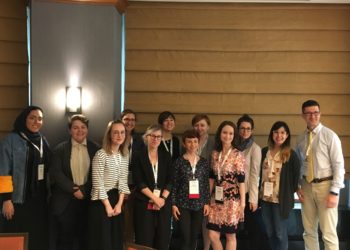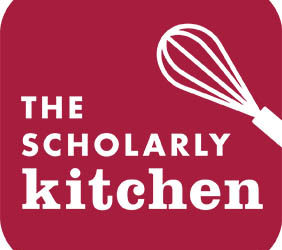Editor’s Note: This guest post is from the 2018–2019 Annual Meeting Program Committee co-chairs, Ben Mudrak, Cason Lynley, and Yael Fitzpatrick. Ben is a Product Manager for author and reviewer services at the American Chemical Society and has been involved with scholarly communication for 10 years. Cason is the Director of Marketing and Sales for books and journals at Duke University Press and has served for several SSP committees since 2010, including serving as the Annual Meeting co-chair for two years. Yael is the newest co-chair on the committee, and has been active with SSP for a number of years. She is a consulting art director, designer, and brand manager for the scholarly publishing community, and runs Gazelle Design Consultancy.
On May 29th, the forty-first Annual Meeting of the Society for Scholarly Publishing (SSP) kicks off in San Diego, California with the theme “Shaping the New Status Quo: Global Perspectives in Scholarly Publishing.” What does it take to put such a conference together?
The first step is to gather a great committee of knowledgeable, committed, and engaged people to help create it. Our Annual Meeting Program Committee includes more than 30 people from across the scholarly publishing community as well as three co-chairs, key SSP staff, and amazing support from conference professionals. It takes a lot of creativity, commitment, and coordination but it is also a lot of fun. (If this sounds of interest, you can find out how to get involved at the Annual Meeting — just find one of the co-chairs or come to the Get Involved lunch on Friday!)
With a good team together, the next challenge is to decide on a meeting theme. The topic of the meeting helps shape the programming that will be submitted, so it’s important to balance a few key factors. The theme must be broad enough to fit a range of sessions, while simultaneously providing a common thread that can be woven in among five or six meeting tracks and various presentation formats. A strong meeting theme is timely, yet not so specific to a single topic that it can be rendered irrelevant by the time the meeting comes around eight or nine months later. The Program Committee is invaluable for striking this balance, with several early committee calls dedicated to getting the theme just right.
This year, the committee wanted to focus on the trend of diversity and inclusion, evident within SSP, in the broader world of scholarly communication, and beyond. The meeting’s location in San Diego also raised thoughts of connections to regions outside of the United States, like Central American or Asia. There are many perspectives that have not been historically well represented during SSP’s Annual Meeting, and the committee wanted a theme that would inspire proposals and programming designed to bring new voices to the table, both now and as part of a new standard way of communicating scholarship in the future.
With a theme in hand comes one of the fun parts — opening up the call for participation. Thank you to the over 100 of you who sent in proposals for concurrent sessions and pre-meeting seminars! With this volume of great ideas, the process of selecting the final program is quite competitive and requires hard work on the part of the committee. And while it’s never fun rejecting proposals, having such strong submissions contributes to the overall excellence of the program. Each proposal is evaluated and scored by a small group of committee members in a process that is evocative of how scholarly abstracts are reviewed. These reviews help identify the session proposals that feature new ideas, topics that align with the meeting theme, and offer interactivity with the audience.
With over 30 committee members and 100 proposals, we could no longer operate in the world of Google Forms or a single spreadsheet, as we used to. A big thanks to ScholarOne for setting up our SSP Annual Meeting submission site, which also features reviewing tools that let the committee get the job done.
Building on the theme of new and different voices, and in response to attendee demand for increased interactivity, this year we’re exploring some non-traditional programming. We’re excited to introduce a track of concurrent sessions including workshops, an unsession, and a debate, among others. Some of these non-traditional approaches should also keep the meeting nimble and able to address new topics in a timely way. New programming is part of the pre-meeting seminars as well, with a facilitated workshop on identifying and responding to microaggressions in the workplace.
Throughout the process of developing the program, we seek our two keynote speakers — always a challenging process but a rewarding one. We look at last year’s survey responses to get the ball rolling, and form a subcommittee to refine ideas for speakers who may be a good fit for the meeting theme. Some of the challenges in securing a keynote have to do with timing—often their schedule does not work with the conference. We have thick skins for rejections and don’t take those personally! A big lesson learned is to have a long list of candidates, to start as early as possible, and to know that we’ll end up with two fantastic speakers, as was definitely the case this year. A particularly striking comment from last year’s survey was that the keynotes both challenged and inspired the audience, and we think you’ll find that to be the case again this year.
One of the best parts of about working on a committee like this is seeing it all come together at the actual conference. All of the planning transforms into fully fledged seminars, concurrent sessions, and keynote presentations–it feels a little like magic. There’s still time to get the early bird discount if you want to experience this year’s program—just register by April 19th. We hope to see you there!
Discussion
4 Thoughts on "Guest Post – How a Conference Comes Together: The SSP 2019 Annual Meeting"
This is a good overview and I wish SSP all kinds of success with its Annual Meeting in San Diego.
Best wishes from Berlin
Arnoud de Kemp
APE Initiator & Organizer since 2006
http://www.ape2019.eu
Disappointing that you’re not offering virtual opportunities for the full conference or key sessions.
Thank you for your feedback, Carolyn, we definitely appreciate it. Virtual attendance was an offering we had to drop due to low interest during past years, but perhaps we’ll be able to revisit it in the future. In principle it’s certainly a great way to have more people involved in the meeting! The practical logistics are where things can get tricky.
It sounds like you all have had as much fun as Emilie Delquié and I did. I wish you all the best for a very successful conference!




